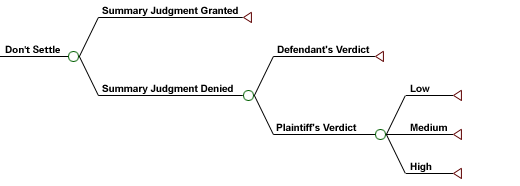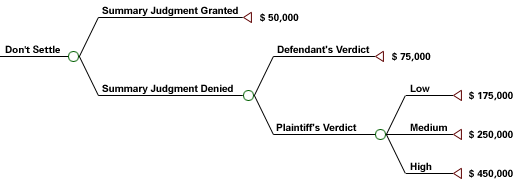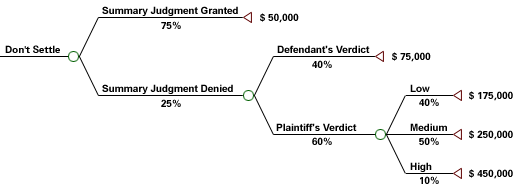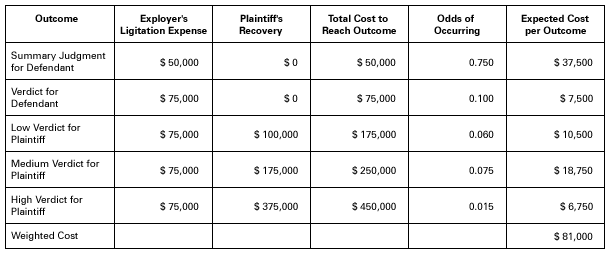What is a Decision Tree?
“What is this case worth?” This inquiry lies at the heart of virtually every settlement negotiation. The central goal of each party is to reach a result that makes the party better off than it would be if the parties kept on litigating. To bargain, we have to know the value of what we are bargaining over. When we know what a case is worth, we can negotiate with confidence. We can objectively weigh what the other side proposes and adopt positions that the other side is likely to take seriously.
It’s often very hard to put a dollar value on a lawsuit, particularly an employment case. Unlike, say, automobiles, there are not so many essentially identical lawsuits that we can easily discern a “market price.” The individual characteristics of employment cases tend to have, relatively speaking, great impact on their value. Change a few details in the fact record or substitute a new trial judge, and the value of the case can plummet or skyrocket. Lawsuits are full of uncertainty, and surprise twists abound. Often, we can’t really predict with any accuracy how they will come out until they are over. Still, the process of valuing a lawsuit is so critical to settlement that we are always seeking ways to do so accurately.
One invaluable technique for determining the value of a case is the decision tree. A decision tree shows the various possible outcomes in a lawsuit and helps the parties evaluate the costs, risks, and benefits of each outcome. In a typical lawsuit–where a plaintiff simply seeks to recover some amount of money from a defendant–a decision tree lists the most likely ways the case can come out and produces a weighted average of the results.
The discussion which follows shows how to build a decision tree to evaluate a sample case. When you’ve read through it, you will be able to use this technique to value your own cases. However, if you don’t want to do the math, there’s a simple alternative. Click on “Create a Sample Decision Tree” on this website. You will find a program that does the work for you by asking you a series of questions and then creating a decision tree using the information you provide.
Step 1: What are the possible outcomes?
The pages that follow illustrate the process of preparing a simple decision tree analysis in a typical employment discrimination case. The participants begin by sketching out, in broad form, the various “paths” that the case is likely to follow. Does the employer expect to file a summary judgment motion? If the case goes to trial, what is the range of probable verdicts the jury might return?
The decision tree described here would be prepared by the mediator and the employer in a “caucus” session. In our sample case, the defendant plans to file a summary judgment motion. If the motion is denied, the case will proceed to trial, and the jury, if it finds for the plaintiff, will have a range of damages it could award. This example typifies a Title VII case, in which the plaintiff’s back pay loss is relatively easy to calculate but in which the jury might award compensatory and punitive damages and will have significant leeway in selecting the amount.
We begin to construct a decision tree by listing the possible outcomes that the case is most likely to reach. They become the branches on the decision tree. Our first illustration shows these possible outcomes. Each time there is more than one possible outcome, the tree branches out:
Step 2: What would be the cost of the possible outcomes?
Next, we estimate the cost to reach each outcome. Since our analysis in this example is from the employer’s point of view, we include the employer’s attorney’s fees and expenses. For those outcomes in which the plaintiff wins, we add in the estimated amount of the jury verdict and the amount the court would probably award the plaintiff in attorney’s fees.
In the second version of the decision tree, we have added the estimated cost of arriving at each possible outcome. We have made the following assumptions:
- If the employer were to win the case on summary judgment and successfully defend its victory on appeal, the cost to do so (in attorney’s fees and expenses) would be $50,000.
- If the employer were to win the case at trial and successfully defend that victory on appeal, the cost to do so (again, in attorney’s fees and expenses) would be $75,000.
- If the plaintiff survived the employer’s summary judgment motion and won at trial, the jury would probably award the plaintiff back pay of $25,000. The jury might also award compensatory and punitive damages. We have condensed the total range of jury verdicts into three; that is, we have assumed the jury would reach one of only three possible verdicts. These are:
- A modest (“low”) award of back pay alone, or $25,000;
- A more substantial (“medium”) verdict that includes $75,000 in compensatory and punitive damages for a total award of $100,000; and
- A generous (“high”) verdict that includes $275,000 in compensatory and punitive damages for a total award of $300,000.
- If the plaintiff prevailed at trial, the court would award the plaintiff $75,000 in attorney’s fees and costs.
The following chart shows the amounts that we estimate the plaintiff would recover in the event of a plaintiff’s verdict:
Components of “Plaintiff’s Recovery”
Once we add the employer’s litigation expenses of $75,000 (the amount we estimated to take the case through trial and appeal), we see the total cost (to the employer) of the “low” plaintiff’s verdict would be $175,000; the total cost of the “medium” plaintiff’s verdict would be $250,000; and the total cost of the “high” plaintiff’s verdict would be $450,000.
When we insert all of the outcome costs, our decision tree looks like this:
Step 3: What is the chance of each possible outcome?
Our next step is to estimate the chances of arriving at each possible outcome. The third decision tree shows the likelihood of each outcome as a percentage, and the percentages of all the possible outcomes at a given stage add up to 100. In our sample case, the employer has estimated it has a 75% chance of winning on summary judgment but concedes that if it loses the summary judgment motion, the plaintiff will have a 60% chance of winning before the jury. The employer has assigned probabilities of 40%, 50%, and 10% to the low, medium, and high verdict amounts.
Step 4: “Rollback”
Having made all of these estimates, we then calculate the overall odds that each outcome would occur and multiply that percentage by the cost of the outcome. When we total up all the products, we get a “weighted” estimate of what the case will cost to litigate at a conclusion. The following image shows these calculations as performed by decision tree software. Like a spreadsheet, the software allows us to change any of the assumptions and immediately see the modified result.
We can view the same set of calculations in a chart or spreadsheet, such as this:
Finally, Some Caveats
Decision tree analysis can be exceptionally valuable, but it has its limitations, too. The list of caveats about the usefulness of this analysis can go on and on. Here are a few:
Decision tree analysis necessarily relies on very rough estimates about future events. The percentages and dollar figures can give a false impression of exactness.
It doesn’t necessarily take into account how wide or narrow the range of outcomes is, which can have an enormous effect on settlement decisions.
It doesn’t consider the parties’ respective aversion to risk.
As performed in these examples, it takes into account the employer’s cost of litigation. The employer may ignore this cost or claim to ignore it.
Viewed from the plaintiff’s perspective, the numbers will be lower since litigation costs won’t be included.
A party may already have made up its mind about the value of the case before the analysis is run.






